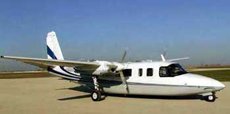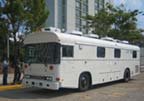Equipment EPA Uses to Collect On-site Air Monitoring Data
During emergencies, EPA may use these vehicles to monitor and sample for substances that may be present in the environment. Use of these vehicles is based on the emergency and on decisions by the response team.
ASPECT: EPA's Airborne Data Collection System

The Airborne Spectral Photometric Environmental Collection Technology, or ASPECT, is a small aircraft EPA uses to detect and gather chemical and radiological data to assist response agencies in the US. ASPECT uses a variety of sensors and cameras that can quickly collect data and information and provide it to emergency response teams. Read more about ASPECT.
TAGA: EPA's Mobile Sampling and Analysis System

In response to a disaster, EPA uses a self-contained mobile laboratory to monitor air quality. The lab bus, the Trace Atmospheric Gas Analyzer, or TAGA, is capable of real-time sampling and analysis. It can detect chemicals at very low levels. TAGA also has specialized sampling equipment to use at remote locations and to measure air quality. TAGA aids EPA's efforts to rapidly identify and address potential environmental threats in disaster areas. Read about other EPA response equipment.
